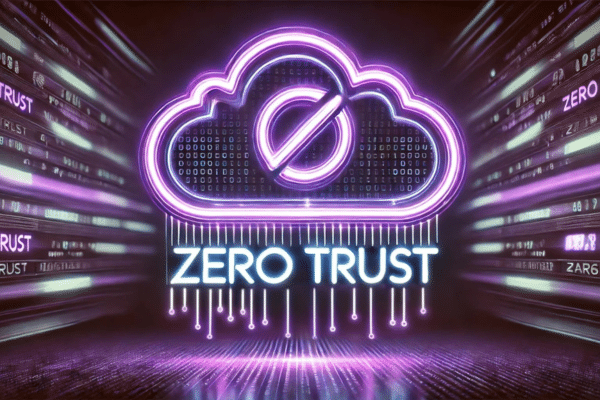What Is Zero Trust and Why Are Traditional Security Models No Longer Sufficient?
For years, IT security was based on a simple principle: anyone within the corporate network was considered trustworthy. However, modern threats have rendered this approach obsolete. Cloud technologies, remote work, and increasingly sophisticated cyberattacks put traditional security mechanisms such as firewalls and VPNs under pressure—they are no longer enough to reliably protect organizations.
Zero Trust addresses this challenge by replacing implicit trust with continuous verification. Every access request is scrutinized, every identity is authenticated, and every data transfer is monitored. Businesses are increasingly recognizing the importance of this concept, yet its implementation presents significant challenges.
Zero Trust: Principles and Benefits at a Glance
Zero Trust follows a fundamental principle: “Trust is good—control is better.” Traditional security models assumed that threats primarily originated outside the network. Zero Trust challenges this assumption, ensuring that every access request is verified, regardless of location.
The Five Core Principles of Zero Trust:
- Strict Identity Verification: Access to IT resources requires clear identity authentication—Multi-Factor Authentication (MFA) is essential.
- Least Privilege Access: Users and systems receive only the permissions necessary for their tasks.
- Continuous Monitoring: All network activity is analyzed in real-time, with suspicious behavior immediately detected and blocked.
- Microsegmentation: The network is divided into smaller, isolated segments, limiting potential damage in case of a security incident.
- Zero Trust Network Access (ZTNA): Users gain access only to the applications they need, without exposing the entire network.
Instead of relying on firewalls or VPNs alone, Zero Trust takes security a step further—ensuring protection at every level of IT infrastructure.
Advantages of a Zero Trust Architecture:
- Enhanced Data Security: Every access request is verified, minimizing data breaches.
- Improved Compliance: Facilitates adherence to regulatory frameworks such as GDPR and NIS2.
- Reduced Attack Surface: Strict access controls lower the risk of successful cyberattacks.
- Protection Against Insider Threats: Even internal users and systems must continuously authenticate.
- Optimized IT Resources: Security measures are applied precisely where they are needed most.
Zero Trust Infrastructure: Standards and Frameworks
Zero Trust is supported by various security standards and frameworks, providing businesses with a solid foundation for implementation. Key standards include:
- NIST 800-207: Comprehensive guidelines for Zero Trust architectures.
- Cloud Security Alliance (CSA) Zero Trust Advancement Center: Maturity models for Zero Trust adoption in cloud environments.
- ISO/IEC 27017: Security standards for cloud computing that complement Zero Trust.
- ENISA Zero Trust Guidelines: Recommendations from the European Union Agency for Cybersecurity (ENISA) for implementing Zero Trust in enterprises.
- Microsoft Zero Trust Deployment Center: Guidelines for applying Zero Trust in Azure-based cloud environments (relevant for Microsoft users).
Zero Trust in Practice: Industries with a High Need for Protection
Zero Trust is widely adopted across various industries to safeguard IT infrastructures from cyberattacks. This model is particularly crucial in the following sectors:
- Financial Services: Protecting sensitive transaction and customer data through granular access controls.
- Healthcare: Ensuring that patient records can only be accessed by authorized personnel.
- Public Sector: Securing government data against cyber threats.
- Manufacturing & Industry: Safeguarding connected production systems and operational technology (OT) from cyberattacks.
- Energy & Utilities: Protecting critical infrastructure and control systems from internal and external threats.
Steps to Successfully Implement Zero Trust
Implementing a Zero Trust model requires a structured approach. Organizations should proceed step by step to systematically close security gaps and establish long-term protection.
1. Assess the IT Landscape
A detailed analysis of the existing IT environment is the first step. This involves identifying all systems, data, and networks, as well as evaluating potential vulnerabilities. Highly sensitive areas should be prioritized.
2. Define Access Controls
Following the Least Privilege principle, users and systems should receive only the permissions necessary for their roles. This significantly reduces the attack surface and ensures critical data remains secure.
3. Implement Multi-Factor Authentication (MFA)
Reliable authentication is essential for Zero Trust. MFA ensures users are verified through multiple security layers, preventing unauthorized access even if credentials are compromised.
4. Automate Security Policies and Access Controls
Protection must be continuous and efficient. Automated policies ensure that every access request is assessed in real time, allowing for immediate detection and blocking of unusual activity.
5. Real-Time Monitoring and AI-Powered Analysis
Continuous monitoring of user behavior, access patterns, and system activity enables early detection of suspicious activities. AI-driven analytics help mitigate threats before they escalate.
6. Gradual Integration and Continuous Optimization
Following the initial implementation, organizations should conduct regular evaluations to identify weaknesses and refine security strategies. Continuous adaptation to emerging threats ensures that the Zero Trust model remains effective in the long run.
Zero Trust as the Foundation of Cloud Transformation
As critical business applications move to the cloud, security requirements continue to evolve. Data that was once protected within on-premises data centers is now distributed across various cloud platforms. This creates new attack surfaces and challenges for access control.
Zero Trust offers a robust solution by:
- Enforcing strict access controls: Every access request is authenticated and authorized in advance.
- Microsegmenting cloud environments: Applications and data are isolated to prevent lateral movement by attackers.
- Enabling real-time security assessments: Continuous validation of access requests helps identify potential threats.
- Integrating DevSecOps principles: Security is embedded early in the development process to minimize vulnerabilities.
Zero Trust: The Future of IT Security
Zero Trust is a fundamental security approach for organizations seeking to minimize IT risks sustainably. It enforces consistent access control, reduces attack surfaces, and strengthens IT resilience. Adopting Zero Trust not only ensures compliance but also proactively protects businesses against cyber threats.
Don’t leave security gaps unaddressed. Implement a Zero Trust strategy and secure your organization for the future. Our experts are here to assist you—contact us for a tailored consultation!
